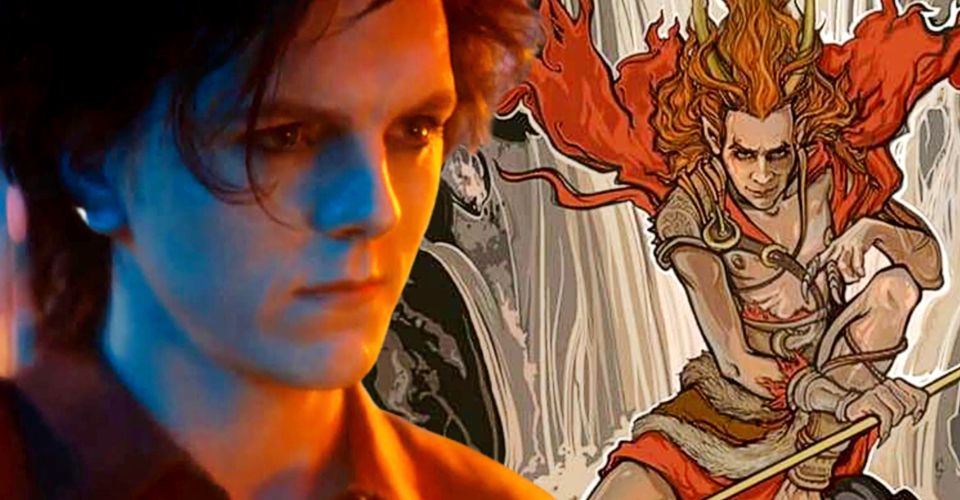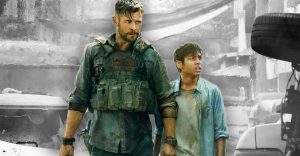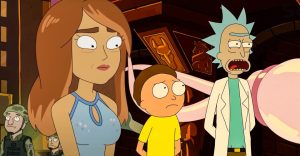Every God In Netflix’s Ragnarok (& How They Compare To Norse Mythology)

Netflix’s Ragnarok season 2 moves away from its usual coming-of-age elements by choosing to flesh out every god whilst further reimagining Norse mythology. Ragnarok season 1 had ended on a feverishly climactic note, with Magne (David Stakston) going up against the Jutul patriarch, Vidar (Gísli Örn Garðarsson), and the latest season picks up right where it left. Portraying the aftermath of the battle, Ragnarok delves deep into Magne’s conflicted psyche, wherein he must reconcile his god-like responsibilities with the moral quandaries of being a human. Ragnarok season 2 released on May 27, 2021, and is available for streaming on Netflix.
The Norwegian fantasy drama upped the ante by shifting its focus on Magne’s brother, Laurits (Jonas Strand Gravli), which paves the way for the big reveal of his true identity and parentage. Throughout season 1, Laurits has been rather ambivalent regarding his stances, although he is unaware of the fact that Vidar is his father at the time. This revelation not only forces Laurits to re-evaluate his loyalties but also drives a wedge between the brothers, who share a volatile, tumultuous relationship throughout season 2. Moreover, it is interesting to note that it is Laurits’ arc that sows the seeds for the mythic retelling of the end of the world – the great battle between Gods and Giants, or Ragnarök.
While most of the Gods throughout the show, especially the reincarnations of Odin and Freya, seem to heavily lean towards the old ways, most of the mythmaking has been re-contextualized in a modern context. This sets the stage for a conflict between the old and the new, which is condensed within Magne’s moral dilemma regarding the necessity of violence and murder in his war against the Jutuls. Here’s a deep dive into every God in Ragnarok, their possible motivations, and how they compare to traditional Norse mythology as a whole.
Odin

Deemed supreme among the Æsir, Odin has been hailed as the Allfather with incredible mastery over scared wisdom, war, poetry, and magic. Norse mythology chronicles Odin’s great thirst for knowledge, which culminated in him hanging from the Yggdrasil or the World Tree for nine whole days. In Ragnarok, Odin is reincarnated within the body of Wotan Wagner, an elderly man who is seen riding an electric wheelchair through seasons 1 and 2. Wotan’s true identity is only revealed after Wenche’s death, although visual cues foreshadow this development, such as his eye patch and the fact that Odin is referred to as Wotan in other Germanic tongues. Also, as Wenche is positioned as the seer who tells Odin about Völuspá or Seer’s Prophecy concerning Ragnarok, her death forces Odin to assume a more direct role in the events that haunt Edda.
While Wotan, or Odin, is willing to assist Magne in his mission to forge Thor’s hammer, Mjölnir and destroy the Giants once and for all, he is insistent in following the old ways, which usually involved extreme violence and necessary deaths in order to bring about a new beginning. Although Odin explains that the old ways cannot be interpreted against modern moralistic standards, Magne emphasizes the fact that they do live in the modern world, adaptation and change being necessary tenets of their immediate reality. Odin also immediately rejects Laurits, who is a reincarnation of Loki, as he is aware of the seminal role he will come to play in triggering Ragnarok, as per the Völuspá. However, is it possible that Odin’s blind rejection of Laurits is exactly what further intensifies the latter’s already-fractured psyche, pushing him to side with the Giants?
Freyja

Associated with love, fertility, war, and magic, Freyja is traditionally known for her electrifying beauty and ability to enchant any being. Freyja is reincarnated in the form of Iman, who is shown taking care of Wotan as part of her part-time job, whilst being a student at Edda Secondary High. While season 1 enwrapped Iman in an aura of mystery, season 2 reveals her as a potential ally to Magne, as the two work closely together to come up with a plan to defeat the Jutuls. Over time, Iman is able to master her powers, which include compulsion and seduction, but chooses to use them to shop for free and improve her grades at school. Although loyal to the mission, Iman harbors a kernel of intensity within her and shares some traits with the Norse goddess, such as the urge to live a flamboyant life and being confident in their sexual identity. Despite their temporary fallout, Iman plays an integral role in helping Magne in his mission to forge Mjölnir, as she manages to hold off Fjor while the hammer is forged on the eternal fire.
Thor

Hailed as the protector of humanity and the god of lighting, Thor is traditionally known for defeating the World Serpent and ending Ragnarok, facilitating rebirth for the world and humanity as a whole. As Magne is a reincarnation of Thor, his powers include superhuman strength, speed, agility, the ability to influence the elements (especially thunder), and perhaps the only being who is able to lift and use Mjölnir. Much like Thor, Magne exudes bravery and strength even in the direst of situations, while being extremely compassionate and protective of those he cares about. However, the most important trait that Magne shares with Thor is the sense of righteousness, which acts as the fulcrum for his crisis of identity throughout Ragnarok season 2. Broken by the weight of the truth about the true nature of his brother, Magne is understandably conflicted about his role in the bigger scheme of things.
Having lost Isolde, his only true friend in Edda, to the cruelty of the Jutuls, Magne feels utterly lost and isolated after his fight with Vidar. While Iman offers help for some time, their eventual fallout further intensifies the tussle between what needs to be done and what is morally right. It is also interesting to note that Magne is named after Thor’s son, Magni, who is a result of a relationship between Thora and the Giant Járnsaxa, which is mirrored in the surreal sequence in which Magne and Saxa have sex. Also, after accidentally killing Vidar in a fight, Magne is wracked with immense guilt, which is further intensified by Laurits’ unwillingness to forgive his brother. Magne undergoes a test of faith after his powers are taken from him, which are returned once he completely embraces his identity as Thor whilst choosing to protect his brother, Laurits. This begs the question: is everything truly predetermined or will Magne be able to exercise some amount of personal agency in a potential Ragnarok season 3?
Loki

Known for his notorious trickster sensibilities, Loki is traditionally considered a part of the Æsir despite having descended from the Giants. Season 2 reveals Laurits as Loki, a twist that had been foreshadowed since season 1. Much like Loki, Laurits is genderfluid and harbors a mischievous streak, while undergoing a massive struggle with his core identity. While Magne’s motivations remain constant and clear throughout, Loki is unpredictable, to say the least, as it is difficult to gauge whose side he is truly on. After learning the truth about his parentage, Laurits forges a bond with Vidar, his true father, and finds solace in his company. However, things go awry when Vidar learns of Laurits’ motivations to help his brother, leading to a string of events that result in Vidar’s death at the hands of Magne. Angry, lost, and wracked with pain, Laurits lashes out at Magne and the rest of Edda.
Although his powers are activated, Laurits’ abilities are not manifested in the conventional sense, apart from near-invulnerability and the ability to withstand pain and heal instantly. Mirroring mythology in a modern context, Laurits births and fathers Jörmungandr, or the World Serpent, who will eventually become a key weapon against Thor during Ragnarok. As Jörmungandr essentially represents an ouroboros, it hints at the themes of destruction and rebirth, along with the cyclical nature of things, underlining the importance of predestination. Season 2 ends with Laurits striking a deal with the Jutuls and him releasing Jörmungandr into the ocean, which serves as foreshadowing, as Ragnarok began with the violent unrest of the sea and the uncurling of the ouroboros. As Loki is traditionally also known for shapeshifting, it remains to be seen whether Laurits is able to master this ability.
Tyr

Quintessentially known as the God of war in Norse and Germanic mythologies, Tyr is known for his excellent combat abilities and war manipulation. Tyr is reincarnated in Harry, a mechanic at the auto repair shop in Edda. Most surviving narratives about Tyr state that he sacrifices his hand to the monstrous wolf Fenrir, who bites off his limb while the gods bind the wolf. In a slightly altered fashion, Tyr loses his hand during an altercation with Fjor, although this sacrifice allows Magne to escape with Mjölnir. While Harry has not been fleshed out as a character yet, he appears to be loyal to Odin’s cause, is mercurial in terms of temper, and seems to have forged a romantic relationship with Iman.
As Ragnarokseason 2 ends with Laurits releasing Jörmungandr into the ocean, it is most likely that season 3 will witness a skip-ahead in time, taking place after a few years. With Ran and Fjor planning to strike back with full force and Saxa harboring her own fluid intentions, it is likely that allegiances will shift and alter with time. New players will most likely be introduced while existing characters might be imbued with new layers, such as the role of Signy in Magne’s arc and how Gry is integral to the plot in terms of both Magne and Fjor. Whether the world deserves to undergo a rebirth, remains to be seen.
About The Author


















